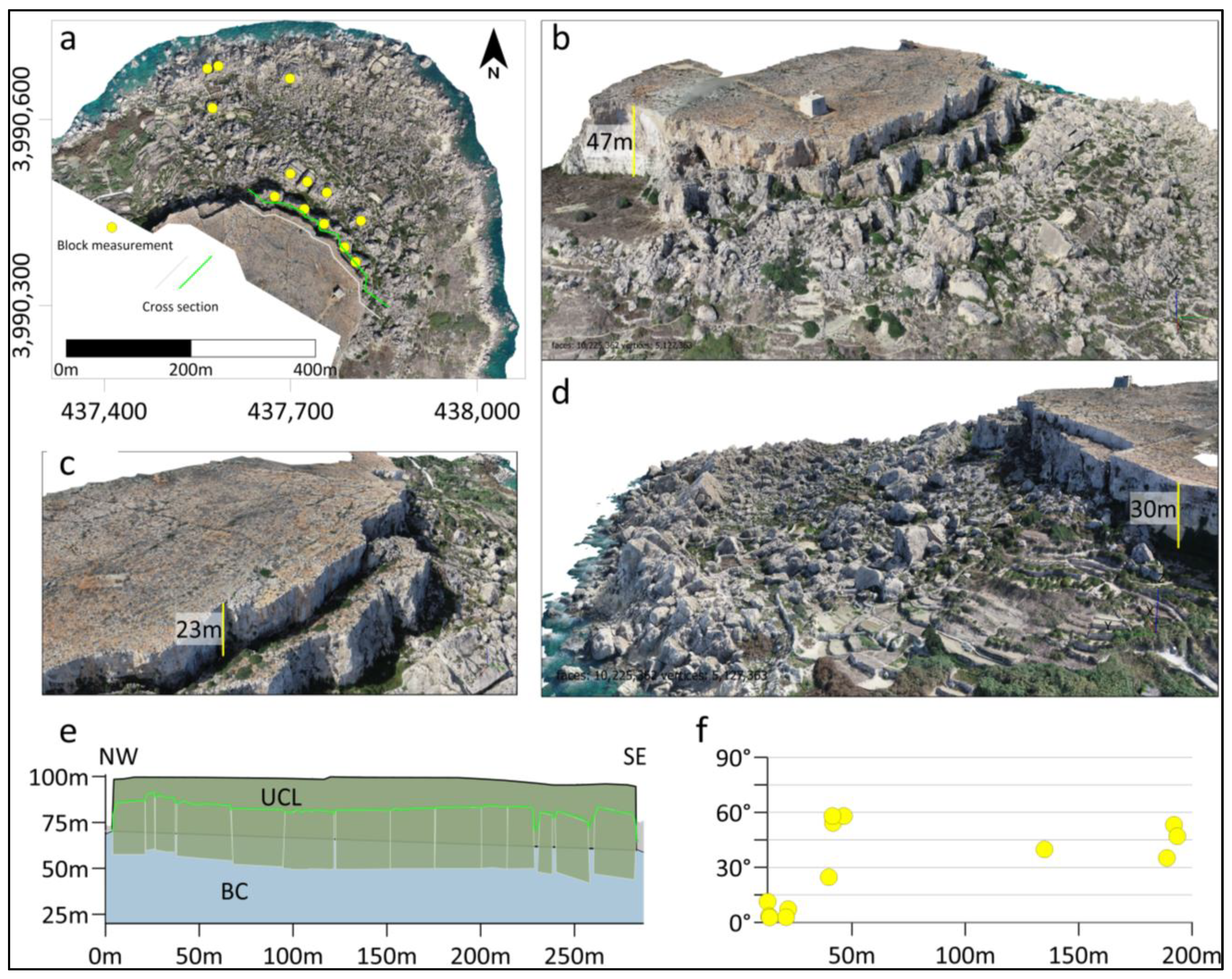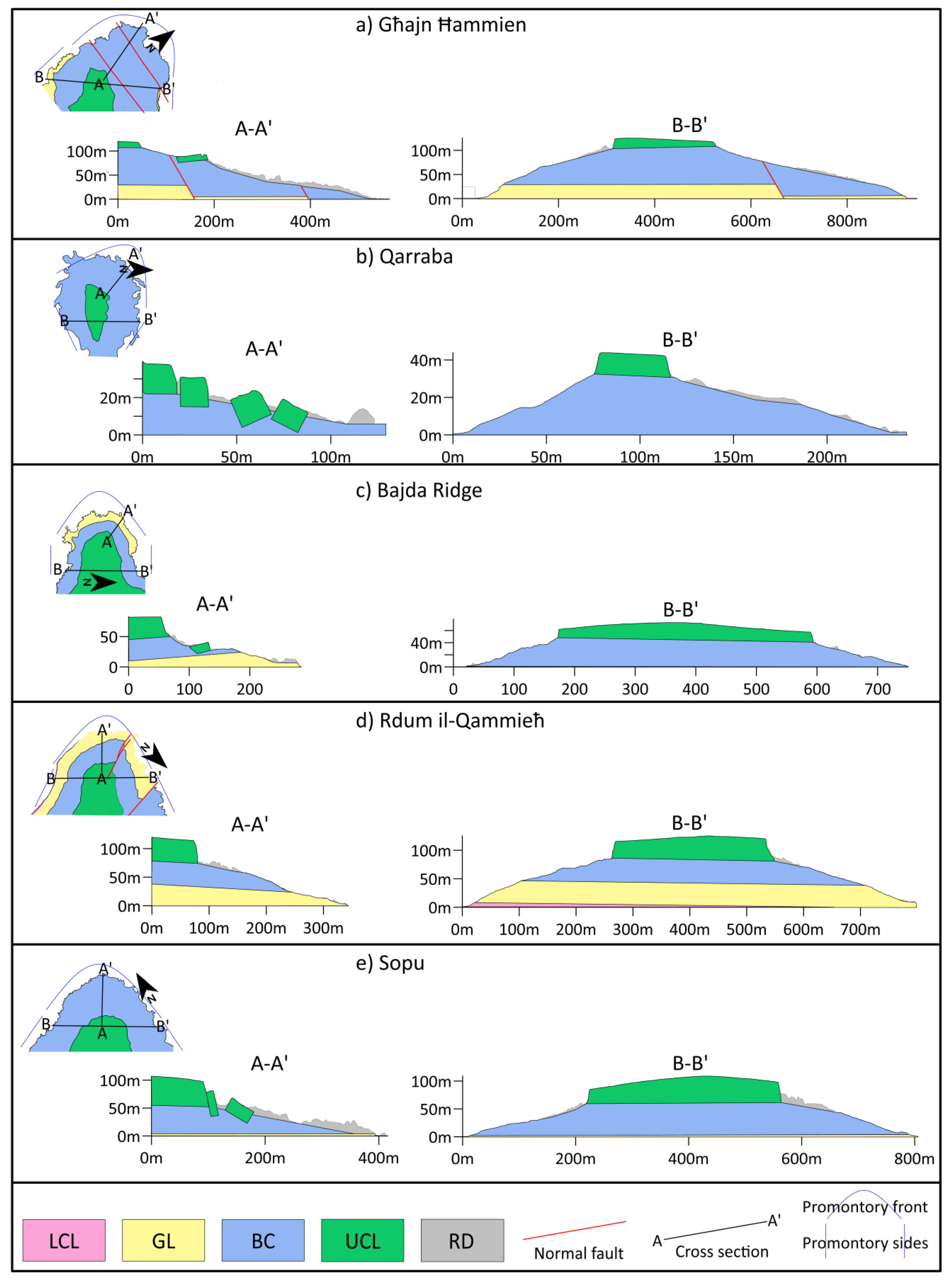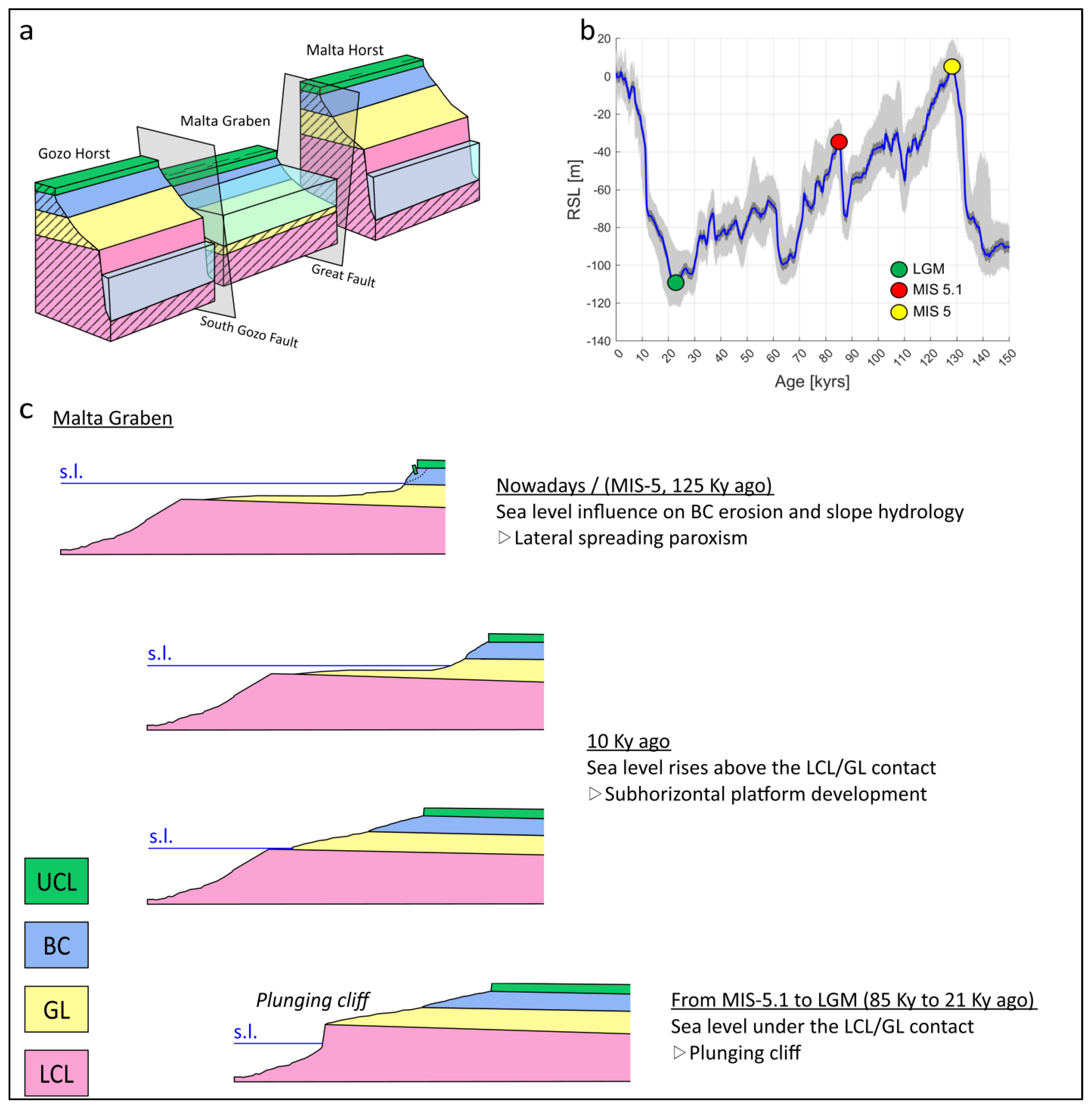Evolution of Coastal Cliffs Characterized by Lateral Spreading in the Maltese Archipelago
Abstract
1. Introduction
2. Geological and Geomorphological Settings
3. Methods
3.1. Digital Outcrop Models
3.2. Remote Sensing Analysis
4. Results
4.1. Main Process Involved in the Relief Rdum Il-Qammieh Promontory
4.2. The Main Process Involved in the Sopu Promontory
4.3. Promontory Cross-Sections
4.4. Distribution of Main Slope Deposits
5. Discussion
5.1. Main Geomorphological Process
5.2. Structural and Sea Level Influences on Maltese Coastal Cliff Development
5.3. A Conceptual Model for the Promontory Evolution at the Malta Graben
6. Conclusions
Author Contributions
Funding
Data Availability Statement
Acknowledgments
Conflicts of Interest
References
- Sunamura, T. Rocky Coast Processes: With Special Reference to the Recession of Soft Rock Cliffs. Proc. Jpn. Acad. Ser. B 2015, 91, 481–500. [Google Scholar] [CrossRef]
- Gunzburger, Y.; Merrien-Soukatchoff, V.; Guglielmi, Y. Influence of Daily Surface Temperature Fluctuations on Rock Slope Stability: Case Study of the Rochers de Valabres Slope (France). Int. J. Rock Mech. Min. Sci. 2005, 42, 331–349. [Google Scholar] [CrossRef]
- Cruden, D.M.; Varnes, D.J. Landslide Types and Processes, Special Report, Transportation Research Board, National Academy of Sciences. Spec. Rep. Natl. Res. Counc. Transp. Res. Board 1996, 247, 36–75. [Google Scholar]
- Hungr, O.; Leroueil, S.; Picarelli, L. The Varnes Classification of Landslide Types, an Update. Landslides 2014, 11, 167–194. [Google Scholar] [CrossRef]
- Carobene, L.; Cevasco, A. A Large Scale Lateral Spreading, Its Genesis and Quaternary Evolution in the Coastal Sector between Cogoleto and Varazze (Liguria—Italy). Geomorphology 2011, 129, 398–411. [Google Scholar] [CrossRef]
- Colica, E.; Galone, L.; D’Amico, S.; Gauci, A.; Iannucci, R.; Martino, S.; Pistillo, D.; Iregbeyen, P.; Valentino, G. Evaluating Characteristics of an Active Coastal Spreading Area Combining Geophysical Data with Satellite, Aerial, and Unmanned Aerial Vehicles Images. Remote Sens. 2023, 15, 1465. [Google Scholar] [CrossRef]
- Mateos, R.M.; Ezquerro, P.; Azañón, J.M.; Gelabert, B.; Herrera, G.; Fernández-Merodo, J.A.; Spizzichino, D.; Sarro, R.; García-Moreno, I.; Béjar-Pizarro, M. Coastal Lateral Spreading in the World Heritage Site of the Tramuntana Range (Majorca, Spain). The Use of PSInSAR Monitoring to Identify Vulnerability. Landslides 2018, 15, 797–809. [Google Scholar] [CrossRef]
- Soldati, M.; Barrows, T.T.; Prampolini, M.; Fifield, K.L. Cosmogenic Exposure Dating Constraints for Coastal Landslide Evolution on the Island of Malta (Mediterranean Sea). J. Coast. Conserv. 2018, 22, 831–844. [Google Scholar] [CrossRef]
- Tomás, R.; Abellán, A.; Cano, M.; Riquelme, A.; Tenza-Abril, A.J.; Baeza-Brotons, F.; Saval, J.M.; Jaboyedoff, M. A Multidisciplinary Approach for the Investigation of a Rock Spreading on an Urban Slope. Landslides 2018, 15, 199–217. [Google Scholar] [CrossRef]
- Furlani, S.; Antonioli, F.; Colica, E.; D’Amico, S.; Devoto, S.; Grego, P.; Gambin, T. Sea Caves and Other Landforms of the Coastal Scenery on Gozo Island (Malta): Inventory and New Data on Their Formation. Geosciences 2023, 13, 164. [Google Scholar] [CrossRef]
- Leucci, G.; Persico, R.; De Giorgi, L.; Lazzari, M.; Colica, E.; Martino, S.; Iannucci, R.; Galone, L.; D’Amico, S. Stability Assessment and Geomorphological Evolution of Sea Natural Arches by Geophysical Measurement: The Case Study of Wied Il-Mielah Window (Gozo, Malta). Sustainability 2021, 13, 12538. [Google Scholar] [CrossRef]
- Sammut, S.; Gauci, R.; Drago, A.; Gauci, A.; Azzopardi, J. Pocket Beach Sediment: A Field Investigation of the Geodynamic Processes of Coarse-Clastic Beaches on the Maltese Islands (Central Mediterranean). Mar. Geol. 2017, 387, 58–73. [Google Scholar] [CrossRef]
- Devoto, S.; Hastewell, L.J.; Prampolini, M.; Furlani, S. Dataset of Gravity-Induced Landforms and Sinkholes of the Northeast Coast of Malta (Central Mediterranean Sea). Data 2021, 6, 81. [Google Scholar] [CrossRef]
- Colica, E.; D’Amico, S.; Iannucci, R.; Martino, S.; Gauci, A.; Galone, L.; Galea, P.; Paciello, A. Using Unmanned Aerial Vehicle Photogrammetry for Digital Geological Surveys: Case Study of Selmun Promontory, Northern of Malta. Environ. Earth Sci. 2021, 80, 551. [Google Scholar] [CrossRef]
- Devoto, S.; Forte, E.; Mantovani, M.; Mocnik, A.; Pasuto, A.; Piacentini, D.; Soldati, M. Integrated Monitoring of Lateral Spreading Phenomena along the North-West Coast of the Island of Malta Coastal Instability Rock Spreading GPS SAR Interferometry GPR Malta. In Landslide Science and Practice; Springer: Berlin/Heidelberg, Germany, 2013; pp. 235–242. [Google Scholar]
- Galea, P.; D’Amico, S.; Farrugia, D. Dynamic Characteristics of an Active Coastal Spreading Area Using Ambient Noise Measurements—Anchor Bay, Malta. Geophys. J. Int. 2014, 199, 1166–1175. [Google Scholar] [CrossRef][Green Version]
- Galone, L.; D’Amico, S.; Colica, E.; Iregbeyen, P.; Galea, P.; Rivero, L.; Villani, F. Assessing Shallow Soft Deposits through Near-Surface Geophysics and UAV-SfM: Application in Pocket Beaches Environments. Remote Sens. 2024, 16, 40. [Google Scholar] [CrossRef]
- Iannucci, R.; Martino, S.; Paciello, A.; D’Amico, S.; Galea, P. Engineering Geological Zonation of a Complex Landslide System through Seismic Ambient Noise Measurements at the Selmun Promontory (Malta). Geophys. J. Int. 2018, 213, 1146–1161. [Google Scholar] [CrossRef]
- Iannucci, R.; Martino, S.; Paciello, A.; D’Amico, S.; Galea, P. Investigation of Cliff Instability at Għajn Ħadid Tower (Selmun Promontory, Malta) by Integrated Passive Seismic Techniques. J. Seism. 2020, 24, 897–916. [Google Scholar] [CrossRef]
- Mantovani, M.; Devoto, S.; Forte, E.; Mocnik, A.; Pasuto, A.; Piacentini, D.; Soldati, M. A Multidisciplinary Approach for Rock Spreading and Block Sliding Investigation in the North-Western Coast of Malta. Landslides 2013, 10, 611–622. [Google Scholar] [CrossRef]
- Panzera, F.; Tortorici, G.; Romagnoli, G.; Marletta, G.; Catalano, S. Empirical Evidence of Orthogonal Relationship between Directional Site Effects and Fracture Azimuths in an Active Fault Zone: The Case of the Mt. Etna Lower Eastern Flank. Eng. Geol. 2020, 279, 105900. [Google Scholar] [CrossRef]
- Pistillo, D.; Colica, E.; D’Amico, S.; Farrugia, D.; Feliziani, F.; Galone, L.; Iannucci, R.; Martino, S. Engineering Geological and Geophysical Investigations to Characterise the Unstable Rock Slope of the Sopu Promontory (Gozo, Malta). Geosciences 2024, 14, 39. [Google Scholar] [CrossRef]
- Dart, C.J.; Bosence, D.W.J.; McClay, K.R. Stratigraphy and Structure of the Maltese Graben System. J. Geol. Soc. 1993, 150, 1153–1166. [Google Scholar] [CrossRef]
- Galea, P. Central Mediterranean Tectonics—A Key Player in the Geomorphology of the Maltese Islands. In Landscapes and Landforms of the Maltese Islands; Gauci, R., Schembri, J.A., Eds.; Springer International Publishing: Cham, Switzerland, 2019; pp. 19–30. ISBN 978-3-030-15456-1. [Google Scholar]
- Micallef, A.; Camerlenghi, A.; Georgiopoulou, A.; Garcia-Castellanos, D.; Gutscher, M.-A.; Lo Iacono, C.; Huvenne, V.A.I.; Mountjoy, J.J.; Paull, C.K.; Le Bas, T.; et al. Geomorphic Evolution of the Malta Escarpment and Implications for the Messinian Evaporative Drawdown in the Eastern Mediterranean Sea. Geomorphology 2019, 327, 264–283. [Google Scholar] [CrossRef]
- Pedley, H.M.; House, M.R.; Waugh, B. The Geology of Malta and Gozo. Proc. Geol. Assoc. 1976, 87, 325–341. [Google Scholar] [CrossRef]
- Hunt, C.O. Quaternary Deposits in the Maltese Islands: A Microcosm of Environmental Change in Mediterranean Lands. GeoJournal 1997, 41, 101–109. [Google Scholar] [CrossRef]
- Galone, L.; Villani, F.; Colica, E.; Pistillo, D.; Baccheschi, P.; Panzera, F.; Galindo-Zaldívar, J.; D’Amico, S. Integrating Near-Surface Geophysical Methods and Remote Sensing Techniques for Reconstructing Fault-Bounded Valleys (Mellieha Valley, Malta). Tectonophysics 2024, 875, 230263. [Google Scholar] [CrossRef]
- Pedley, M. The Calabrian Stage, Pleistocene Highstand in Malta: A New Marker for Unravelling the Late Neogene and Quaternary History of the Islands. J. Geol. Soc. 2011, 168, 913–926. [Google Scholar] [CrossRef]
- Villani, F.; D’Amico, S.; Panzera, F.; Vassallo, M.; Bozionelos, G.; Farrugia, D.; Galea, P. Shallow high-resolution geophysical investigation along the western segment of the Victoria Lines Fault (island of Malta). Tectonophysics 2018, 724, 220–233. [Google Scholar] [CrossRef]
- Furlani, S.; Antonioli, F.; Biolchi, S.; Gambin, T.; Gauci, R.; Lo Presti, V.; Anzidei, M.; Devoto, S.; Palombo, M.; Sulli, A. Holocene Sea Level Change in Malta. Quat. Int. 2013, 288, 146–157. [Google Scholar] [CrossRef]
- Serpelloni, E.; Vannucci, G.; Pondrelli, S.; Argnani, A.; Casula, G.; Anzidei, M.; Baldi, P.; Gasperini, P. Kinematics of the Western Africa-Eurasia Plate Boundary from Focal Mechanisms and GPS Data. Geophys. J. Int. 2007, 169, 1180–1200. [Google Scholar] [CrossRef]
- Alexander, D. A Review of the Physical Geography of Malta and Its Significance for Tectonic Geomorphology. Quat. Sci. Rev. 1988, 7, 41–53. [Google Scholar] [CrossRef]
- Gauci, R.; Scerri, S. A Synthesis of Different Geomorphological Landscapes on the Maltese Islands. In Landscapes and Landforms of the Maltese Islands; Gauci, R., Schembri, J.A., Eds.; Springer International Publishing: Cham, Switzerland, 2019; pp. 49–65. ISBN 978-3-030-15456-1. [Google Scholar]
- Pedley, H.M.; House, M.R.; Waugh, B. The Geology of the Pelagian Block: The Maltese Islands. In The Ocean Basins and Margins; Nairn, A.E.M., Kanes, W.H., Stehli, F.G., Eds.; Springer: Boston, MA, USA, 1978; pp. 417–433. ISBN 978-1-4684-3039-4. [Google Scholar]
- Micallef, A.; Spatola, D.; Caracausi, A.; Italiano, F.; Barreca, G.; D’Amico, S.; Petronio, L.; Coren, F.; Facchin, L.; Blanos, R.; et al. Active Degassing across the Maltese Islands (Mediterranean Sea) and Implications for Its Neotectonics. Mar. Pet. Geol. 2019, 104, 361–374. [Google Scholar] [CrossRef]
- Said, G.; Schembri, J. Malta. In Encyclopedia of the World’s Coastal Landforms; Springer: Dordrecht, The Netherlands, 2010; Volume 1, pp. 751–759. ISBN 978-1-4020-8638-0. [Google Scholar]
- Biolchi, S.; Furlani, S.; Devoto, S.; Gauci, R.; Castaldini, D.; Soldati, M. Geomorphological Identification, Classification and Spatial Distribution of Coastal Landforms of Malta (Mediterranean Sea). J. Maps 2014, 12, 87–99. [Google Scholar] [CrossRef]
- Devoto, S.; Biolchi, S.; Bruschi, V.M.; Furlani, S.; Mantovani, M.; Piacentini, D.; Pasuto, A.; Soldati, M. Geomorphological Map of the NW Coast of the Island of Malta (Mediterranean Sea). J. Maps 2012, 8, 33–40. [Google Scholar] [CrossRef]
- Micallef, A.; Foglini, F.; Le Bas, T.; Angeletti, L.; Maselli, V.; Pasuto, A.; Taviani, M. The Submerged Paleolandscape of the Maltese Islands: Morphology, Evolution and Relation to Quaternary Environmental Change. Mar. Geol. 2013, 335, 129–147. [Google Scholar] [CrossRef]
- Linder, W. Digital Photogrammetry; Springer: Berlin/Heidelberg, Germany, 2009; ISBN 978-3-540-92724-2. [Google Scholar]
- Devoto, S.; Macovaz, V.; Mantovani, M.; Soldati, M.; Furlani, S. Advantages of Using UAV Digital Photogrammetry in the Study of Slow-Moving Coastal Landslides. Remote Sens. 2020, 12, 3566. [Google Scholar] [CrossRef]
- Moore, I.D.; Gessler, P.E.; Nielsen, G.A.; Peterson, G.A. Soil Attribute Prediction Using Terrain Analysis. Soil Sci. Soc. Am. J. 1993, 57, 443–452. [Google Scholar] [CrossRef]
- Della Seta, M.; Martino, S.; Scarascia Mugnozza, G. Quaternary Sea-Level Change and Slope Instability in Coastal Areas: Insights from the Vasto Landslide (Adriatic Coast, Central Italy). Geomorphology 2013, 201, 462–478. [Google Scholar] [CrossRef][Green Version]
- Prampolini, M.; Gauci, C.; Micallef, A.S.; Selmi, L.; Vandelli, V.; Soldati, M. Geomorphology of the North-Eastern Coast of Gozo (Malta, Mediterranean Sea). J. Maps 2018, 14, 402–410. [Google Scholar] [CrossRef]
- Grant, K.M.; Rohling, E.J.; Ramsey, C.B.; Cheng, H.; Edwards, R.L.; Florindo, F.; Heslop, D.; Marra, F.; Roberts, A.P.; Tamisiea, M.E.; et al. Sea-Level Variability over Five Glacial Cycles. Nat. Commun. 2014, 5, 5076. [Google Scholar] [CrossRef] [PubMed]
- Mantovani, M.; Bossi, G.; Dykes, A.P.; Pasuto, A.; Soldati, M.; Devoto, S. Coupling Long-Term GNSS Monitoring and Numerical Modelling of Lateral Spreading for Hazard Assessment Purposes. Eng. Geol. 2022, 296, 106466. [Google Scholar] [CrossRef]







| Place | Date | Frontal Overlap | Side Overlap | Photos Aligned/Total | Pixel Size DEM | Pixel Size Orthomosaic |
|---|---|---|---|---|---|---|
| Sopu | September 2021 | 85% | 70% | 1472/1475 | 11.1 cm/pixel | 2.77 cm/pixel |
| Rdum il-Qammieħ | May 2024 | 85% | 70% | 3365/3397 | 13.8 cm/pixel | 2.82 cm/pixel |
| Promontory | Frontal Slope | Lateral Slope | UCL Thickness | BC Thickness | UCL/BC Ratio |
|---|---|---|---|---|---|
| Għajn Ħammien | 13–28° | 16–24° | 10–20 m | 75 m | 0.13–0.26 |
| Qarraba | 13–19° | 21–41° | 15 m | 35 m | 0.42 |
| Bajda Ridge | 10–14° | 16–23° | 30–45 m | 40 m | 0.75–1.12 |
| Rdum il-Qammieħ | 16–19° | 13–16° | 30–40 m | 45 m | 0.66–0.88 |
| Sopu | 11–16° | 13–18° | 25–50 m | 50 m | 0.5–1 |
Disclaimer/Publisher’s Note: The statements, opinions and data contained in all publications are solely those of the individual author(s) and contributor(s) and not of MDPI and/or the editor(s). MDPI and/or the editor(s) disclaim responsibility for any injury to people or property resulting from any ideas, methods, instructions or products referred to in the content. |
© 2024 by the authors. Licensee MDPI, Basel, Switzerland. This article is an open access article distributed under the terms and conditions of the Creative Commons Attribution (CC BY) license (https://creativecommons.org/licenses/by/4.0/).
Share and Cite
Galone, L.; Feliziani, F.; Colica, E.; Fucks, E.; Galindo-Zaldívar, J.; Gauci, R.; Gauci, C.; Grechi, G.; Martino, S.; Rivero, L.; et al. Evolution of Coastal Cliffs Characterized by Lateral Spreading in the Maltese Archipelago. Remote Sens. 2024, 16, 3072. https://doi.org/10.3390/rs16163072
Galone L, Feliziani F, Colica E, Fucks E, Galindo-Zaldívar J, Gauci R, Gauci C, Grechi G, Martino S, Rivero L, et al. Evolution of Coastal Cliffs Characterized by Lateral Spreading in the Maltese Archipelago. Remote Sensing. 2024; 16(16):3072. https://doi.org/10.3390/rs16163072
Chicago/Turabian StyleGalone, Luciano, Federico Feliziani, Emanuele Colica, Enrique Fucks, Jesús Galindo-Zaldívar, Ritienne Gauci, Christopher Gauci, Guglielmo Grechi, Salvatore Martino, Lluís Rivero, and et al. 2024. "Evolution of Coastal Cliffs Characterized by Lateral Spreading in the Maltese Archipelago" Remote Sensing 16, no. 16: 3072. https://doi.org/10.3390/rs16163072
APA StyleGalone, L., Feliziani, F., Colica, E., Fucks, E., Galindo-Zaldívar, J., Gauci, R., Gauci, C., Grechi, G., Martino, S., Rivero, L., & D’Amico, S. (2024). Evolution of Coastal Cliffs Characterized by Lateral Spreading in the Maltese Archipelago. Remote Sensing, 16(16), 3072. https://doi.org/10.3390/rs16163072










